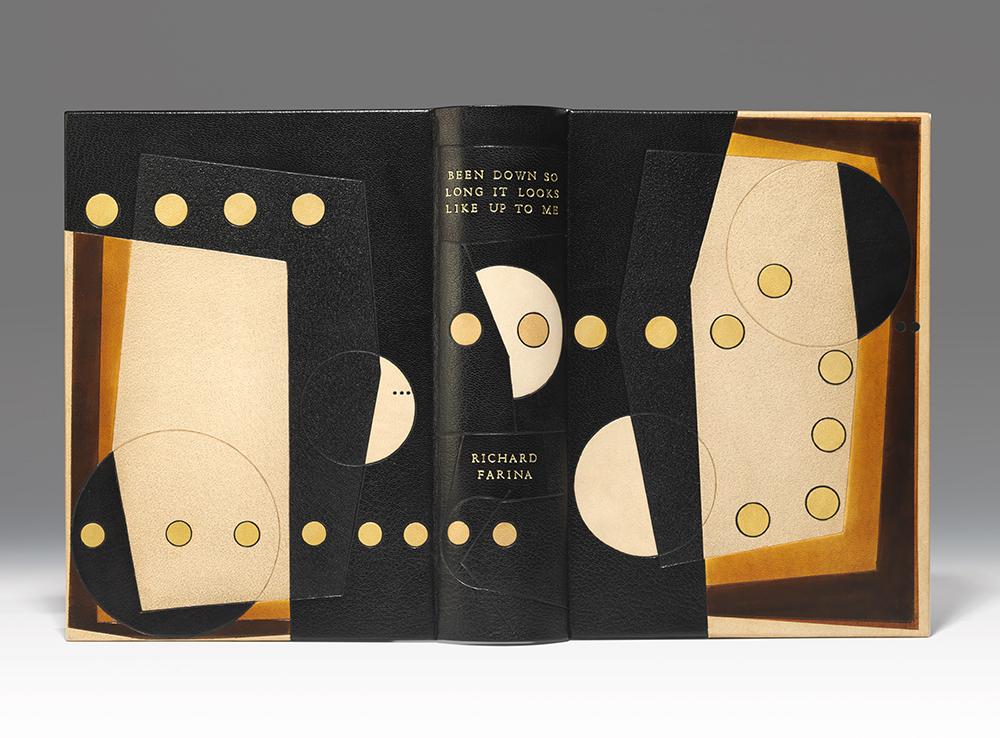Description
“FOR BRUCE, IN GRATITUDE FOR VARIOUS STEAK FINGER AND TAMBOURINE TRIPS. MARCH 1966”: SPECTACULARLY RARE PRE-PUBLICATION PRESENTATION / ASSOCIATION COPY OF RICHARD FARIÑA’S FIRST NOVEL, INSCRIBED BY FARIÑA, TO HIS CLOSE FRIEND AND LONGTIME ACCOMPANIST BRUCE LANGHORNE, THE FOLK MUSIC LEGEND WHO INSPIRED BOB DYLAN’S MR. TAMBOURINE MAN
FARIÑA, Richard. Been Down So Long It Looks Like Up To Me. New York: Random House, (1966). Octavo, original half green cloth, original dust jacket. Housed in a custom half morocco clamshell box.
Exquisitely rare first edition, presentation/association copy, of the author and songwriter’s first novel, warmly praised by his friend Thomas Pynchon, the only novel published in Fariña’s lifetime. inscribed by him to his friend and longtime accompanist, Bruce Langhorne, the inspiration for Bob Dylan’s Mr. Tambourine Man: “for Bruce, in gratitude for various Steak finger & tambourine trips. March 1966.” Accompanied by a typed letter of authentication signed by folk guitar legend Bruce Langhorne.
Richard Fariña’s close friend Thomas Pynchon enthusiastically endorsed this novel: “It’s been a while since I’ve read anything quite so groovy, quite such a joy from beginning to end. This book comes on like the Hallelujah Chorus done by 200 kazoo players with perfect pitch? In spinning his yarn he spins the reader as well, dizzily into a microcosm that manages to be hilarious, chilling, sexy, profound, maniacal, beautiful and outrageous all at the same time.” A respected singer-songwriter as well as author, Fariña dedicated the novel to his wife Mimi, sister of Joan Baez. With “First Printing” on copyright page. The recipient of this extraordinarily rare presentation copy, Bruce Langhorne, was a key session man in the folk scene during the 1960s. He played guitar on all three of Mimi and Richard Fariña’s LPs. Mimi told Guitar Player magazine, “We were both highly influenced by the guitar of Bruce Langhorne. His whole concept of rhythm added a vitality that we wouldn’t have had otherwise.” Langhorne once described his relationship with Richard Fariña as “telepathic.” Fariña and Langhorne were also close friends. The reference in the inscription to “steak finger” has to do with an accident in Langhorne’s youth in which he blew off the tips of some of his fingers. In addition to collaborating with Fariña, Langhorne also played with other influential artists of the time including Joan Baez, Tom Rush, Odetta, and, most notably, Bob Dylan. Langhorne was the inspiration for Bob Dylan’s “Mr. Tambourine Man” and Langhorne’s large Turkish tambourine was part of a recent traveling Dylan exhibition. In fact, while Langhorne and Dylan were friends, Dylan and Fariña were rivals. With both attached to a Baez sister, both struggling to make it as folk singers, and Dylan even calling out Fariña in “Positively Fourth Street” and singing “you’ve got a lot of nerve to say you are my friend; when I was down you just stood there grinning,” conflict was inevitable. Yet, each was able to maintain a strong friendship with Langhorne despite their rivalry. Accordingly, this association copy stands at the center of one of the most famous and tumultuous three-sided relationships in 1960s folk music. Moreover, this book is accompanied by a typed letter signed by Langhorne which reads: “This letter is to authenticate a copy [of] Richard Farina’s novel “Been Down So Long It Looks Like Up To Me,” inscribed for me by Richard Farnia. [sic] I played on Richard and Mimi Farina’s 3 albums and performed with them in concert, and Richard gave me this book while in New York. He wrote “For Bruce, in gratitude for various steakfinger & tambourine trips. March 1966.” [signed] Bruce Langhorne.” Fariña died in a motorcycle accident on his way home from a book signing on April 30, 1966. The novel had been published on April 28, and thus signed copies are extremely scarce. Reportedly only a dozen or so people had been at the the signing, which took place in a small bookstore in northern California. The date of this inscription is the month prior to publication,
meaning this was probably one of the author’s own copies. In those days an author typically received the first 10 copies off the press from the publisher. A superb association copy, which embodies in its association of individuals a history of its era.
Book extremely good, with a few small indentations to boards, faint staining, and slight rubbing to extremities. Dust jacket very good, with two small circular marks to front panel, light soiling, and a bit of wear to extremities. A monumentally rare inscribed presentation copy, exceptionally desirable with such an important association and with an additional letter signed by Bruce Langhorne.




